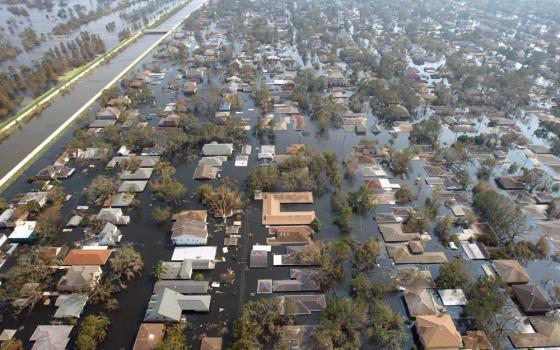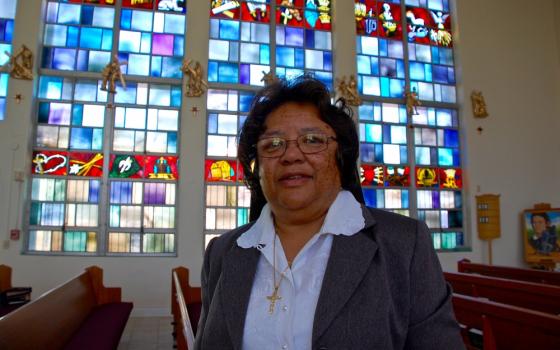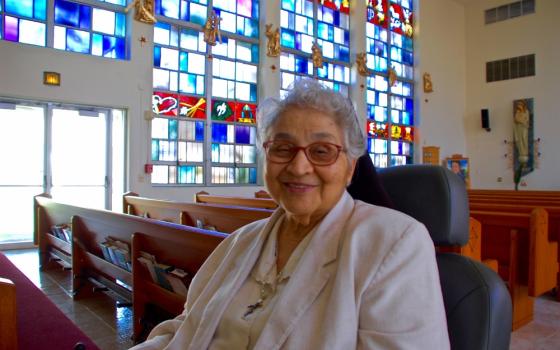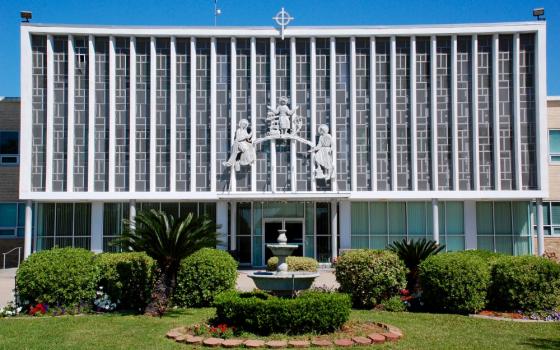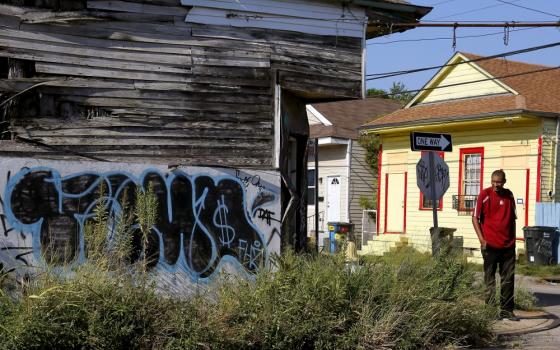The motherhouse had 5 feet of water in it. The school was destroyed. The day care suffered so much damage it has yet to reopen almost 11 years later. The nursing home was wrecked, and, even worse, residents had died there. Sisters were scattered in convents and homes across the state, some with only the clothes on their backs.
But Hurricane Katrina — like slavery, racism within the Catholic church, and yellow fever — could not stop New Orleans' Sisters of the Holy Family from their ministry.
Archbishop Alfred Hughes, then the archbishop of New Orleans, vowed that the church would return to the city after the hurricane, and the sisters said they would, too.
"When the bishop said, 'We're coming back,' I said, 'If they're going back, there's no way the Sisters of the Holy Family are not going back,'" said Sr. Mary Greta Jupiter, now the congregational leader of the 96 sisters in her community. "And the people we serve said, 'You've got to come back. We need you, and you give us hope.'"
The Sisters of the Holy Family returned to New Orleans and worked through the challenges of the aftermath of Hurricane Katrina; in doing so, they found new strength, just like they have since 1842.
"We've always had struggles and challenges," Jupiter said. "We had to struggle to wear a habit. Henriette Delille [the order's founder] never got to wear a habit. She wasn't allowed to because she was black."
Many in the Catholic church in the 1840s didn't believe black women could or should be religious sisters and fought recognition of the congregation, Jupiter said. Although Delille, a free woman of color, established the Sisters of the Holy Family in 1842, she wasn't able to profess first vows until the Vatican recognized the order in 1852.
"It was about 10 years before there was an official habit they could wear," Jupiter said. "And even then, people wondered why they were wearing a habit, saying they were not deserving of it just because of their race. One community of sisters even fought [against] their right to wear a habit."
The sisters ministered people during the yellow fever outbreaks of 1853 and 1897, according to the Sisters of the Holy Family's website. They constantly served people who were economically disadvantaged or struggling, despite sometimes having no food for themselves.
"Several times, the records say, our sisters would go to bed hungry; they would drink sugar water when that was all they had," Jupiter said. "They would teach catechism and care for the sick and elderly all day, then beg in the evening for food."
Even today, people can always get a hot breakfast at the motherhouse, and it's not uncommon to see someone at the door at lunchtime asking for food.
The order's motherhouse, near St. Louis Cathedral, used to be a ballroom where women of color became concubines to wealthy white men, according to Sr. Doris Goudeaux, the congregation's historian. And in the 1800s, a laundry fire destroyed the order's chapel.
Today, the predominantly black order is thriving. In August, when the Leadership Conference of Women Religious (LCWR) holds its annual assembly in Atlanta, Jupiter, the chair of Region 5, which includes New Orleans, will welcome the more than 700 sisters as the host of the event. LCWR represents about 80 percent of the nearly 50,000 women religious in the United States.
"God himself went through trials and tribulations," Jupiter said. "He was not accepted by his people, either. But we've always been a people of faith — that's what keeps us in the Catholic church. We are women made in his likeness."
No one expected the struggles Hurricane Katrina would bring to the order, though, as the storm bore down on New Orleans in August 2005.
At first, government officials recommended that people evacuate the city instead of ordering them to leave. The Holy Family sisters left the motherhouse, taking along the seven members of their community who lived at the nursing home across the street.
When officials finally issued a city-wide order for evacuation just 19 hours before the storm made landfall, it was unclear whether it included nursing homes. At that point, it was too late to find safe transportation for the more than 100 residents at the Sisters of the Holy Family's Lafon Nursing Home.
Twenty staffers at Lafon — including a half-dozen sisters — decided to ride out the storm with the remaining residents, plus some residents' family members. The building was strong and had survived hurricanes before. It had a generator and was well-stocked with food, medicine and supplies.
And the sturdy building did survive the fury of the storm. Of course, the extensive flooding of New Orleans, especially the Ninth Ward where the nursing home was located, is now common knowledge; the first floor of Lafon was was quickly filled with water. Residents were moved to the second floor, but the water wrecked most of the food and supplies and knocked out the generator.
What followed was almost five days of something like hell. No power meant no air conditioning, automatic medical equipment or lights. Medications were used up. Food ran short.
Moving from the flooded first floor — some residents had been up to their chests in water — to the second created extra stress. Once on the second floor, residents were laid on blankets in a hallway, while staffers struggled in the dark. In the unrelenting heat and humidity, residents began to die.
The storm hit on a Sunday night. It was Thursday when one resident's family member was able to get a busload of 40 patients evacuated. On Friday — at last — a fleet of Blackhawk helicopters evacuated the final 59 to safety. In the days that followed, the bodies of 17 residents were recovered from Lafon.
Later, the decision to evacuate Holy Family sisters but not the other residents would be examined repeatedly, with allegations of callous disregard of the residents' lives. The sisters say they did everything possible for everyone they could.
"No one has ever imagined they would ever experience anything like that in their lives," Jupiter said. "The evacuation plans would have worked in ordinary circumstances, but Katrina wasn't ordinary."
Mud, mold and the museum
Coming back after the hurricane was complicated.
Eighty percent of New Orleans had flooded. The effects of Katrina killed at least 1,800 people across the Gulf Coast and displaced more than 400,000 in New Orleans. The city was crippled, flooding had devastated one of the ward's neighborhoods, the Lower Ninth, and in some places, the water was up to 20 feet deep.
"We had insurance, but it [only paid] $1 million to cover all our properties," Jupiter said. "When we had every last one of our institutions that was flooded and wind-damaged, that $1 million didn't go anywhere."
Jupiter and two other Holy Family sisters returned to New Orleans in January 2006, living with another congregation at the only convent in the city that was open. When other sisters returned, it was to trailers set up by the Federal Emergency Management Administration (FEMA).
When the sisters saw the damage, it was shocking.
The school, St. Mary's Academy, had 10 feet of water in it and had to be torn down and rebuilt. The first floor of the motherhouse was filled with mud and mold; the second floor was wind-damaged.
"There was 6 inches of mud [in the motherhouse]," said Jupiter, who was president of the school at the time. "Everything was turned upside-down or pushed against the wall."
The damage was also psychological.
"I was stripped of everything," Jupiter said. "I had no ministry. The place I was working, the place I called home, it was just gone."
There was another loss. The order had been working on Delille's sainthood cause, and tribunals had been held about an alleged miracle and her "life, virtues and reputation of sanctity." Fortunately, all the documents had been boxed up and sent to the Vatican for approval, but in the process of gathering the records and testimony, the congregation had created a museum dedicated to Delille; this was less than two months before Hurricane Katrina came.
"I went down there. We lost everything," Goudeaux said. "That was the biggest loss for me."
(Delille was declared "venerable" in 2010 and is on the road to sainthood.)
All told, the hurricane caused more than $60 million in damage to Holy Family institutions. FEMA paid to rebuild the school and for repairs to the nursing home, but the $8 million to repair the motherhouse came mostly from donations, including from LCWR and congregations around the country.
Goudeaux said the generosity of others was inspiring.
"I was so impressed by the way people came and gave of themselves," Goudeaux said. "At the convent where I stayed in Shreveport, they treated us like guests. It was wonderful."
Investigation and moving forward
The sisters also returned to a criminal investigation into the deaths at the Lafon Nursing Home, which had been the oldest continuously operating nursing home of its kind in the United States until Katrina closed it.
As with St. Rita's Nursing Home in nearby St. Bernard, where 35 residents died during or after the hurricane, government officials investigated whether the sisters had been criminally negligent in not evacuating residents before the storm. There were also lawsuits filed by family members of the residents who died, saying they were owed millions of dollars for their losses.
In 2007, the criminal investigation against the Holy Family sisters was closed and no charges were filed. The class-action suit was dismissed. Now, only lawsuits filed by individuals remain, Jupiter said, and she says that insurance would cover any judgments that might be awarded.
In the days when they were under criminal investigation and their ministries and motherhouse lay devastated, the sisters maintained hope and faith.
"We were grateful for our lives. I looked at it as God showing us these are all material things that can be here today and gone tomorrow," Jupiter said. "We constantly read that God cares for the birds of the air — you'll be taken care of."
There were counselors sent by LCWR to help sisters deal with their losses. There was financial help from FEMA and the Red Cross. There were donations sent by sisters across the country to help rebuild, and college students who volunteered their labor.
The motherhouse and most of Holy Family's ministries were repaired and reopened. St. Mary's Academy was briefly combined with two other Catholic schools but has since been rebuilt and reopened.
Katrina — like all the challenges the Sisters of the Holy Family have faced since 1842 — has strengthened them.
"We're definitely stronger. And wiser. We built stronger, and we built safer," Jupiter said.
To ensure that history of resilience is not lost, the archives for the congregation have been rebuilt, too. And they're now on the second floor.
Nearly 11 years later, the sisters can concentrate on their work. St. Mary's Academy provides Catholic education for girls from pre-K to 12th grade. Lafon Nursing Home reopened in 2010. The sisters run an independent living center for senior citizens, an affordable housing complex for seniors and a food program.
In 2014, a portrait of Henriette Delille was installed in the motherhouse, showing Delille doing just what the Sisters of the Holy Family have done since their founding and continue to do today, serving the people of New Orleans.
[Dan Stockman is national correspondent for Global Sisters Report. His email address is [email protected]. Follow him on Twitter or on Facebook.]
